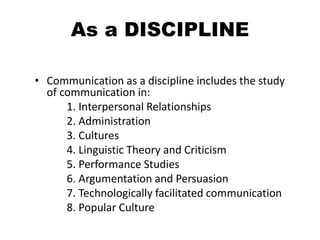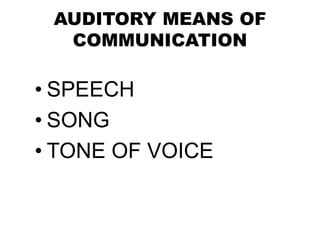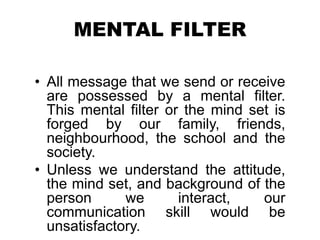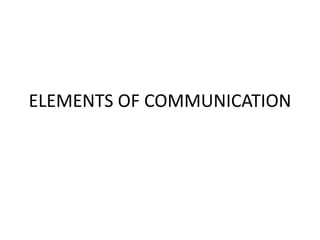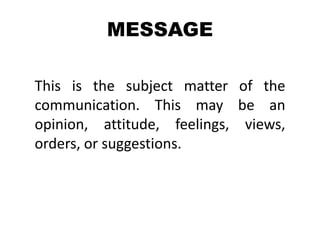Discipline of communication
- 1. THE DISCIPLINE OF COMMUNICATION APPLIED SOCIAL SCIENCE
- 2. DISCIPLINE OF COMMUNITCATION тАв Focuses on how humans use verbal and non-verbal messages to create meaning in various settings (from two persons, groups, to mass audiences across nations using a diverse sets of networks and media. тАв The Discipline is especially interested in the influence of those messages in human behavior.
- 3. As a DISCIPLINE тАв Communication as a discipline includes the study of communication in: 1. Interpersonal Relationships 2. Administration 3. Cultures 4. Linguistic Theory and Criticism 5. Performance Studies 6. Argumentation and Persuasion 7. Technologically facilitated communication 8. Popular Culture
- 4. DISCIPLINE OF COMMUNITCATION тАв Communication focuses on the process of clearly expressing and understanding ideas in written, verbal, nonverbal, and multimodal forms. тАв KEY COMPONENT 1. Understanding and the analysis of linguistic/ communication context. 2. The development of suitable and Effective responses.
- 5. AUDITORY MEANS OF COMMUNICATION тАв SPEECH тАв SONG тАв TONE OF VOICE
- 6. NONVERBAL MEANS OF COMMUNICATION тАв BODY LANGUAGE тАв SIGN LANGUAGE тАв PARA LANGUAGE тАв TOUCH тАв EYE CONTACT тАв MEDIA тАв PICTURES тАв GRAPHIC AND SOUNDS тАв WRITING
- 7. NOTA BENE: Communication skill is not language specific! It is not as yet speakers of a particular language have refined communication skills, while the speakers of some other language have raw communication skills
- 8. MENTAL FILTER тАв All message that we send or receive are possessed by a mental filter. This mental filter or the mind set is forged by our family, friends, neighbourhood, the school and the society. тАв Unless we understand the attitude, the mind set, and background of the person we interact, our communication skill would be unsatisfactory.
- 9. WHY DO WE COMMUNICATE? 1. We communicate to PERSUADE. 2. We communicate in order to give or provide information.
- 11. SENDER The person who intends to convey the message with the intention of passing information and ideas to others is known as sender or communicator.
- 12. RECEIVER Receiver is the person who receives the message or for whom the message is meant for. It is the receiver who tries to understand the message in the best possible manner in achieving the desired objectives.
- 13. MESSAGE This is the subject matter of the communication. This may be an opinion, attitude, feelings, views, orders, or suggestions.
- 14. CHANNEL The person who is interested in communicating has to choose the channel for sending the required information, ideas etc. This information is transmitted to the receiver through certain channels which may be either formal or informal.
- 15. FEEDBACK Feedback is the process of ensuring that the receiver has received the message and understood in the same sense as sender meant it.
- 17. 1. INTRAPERSONAL COMMUNICATION яВз INTRAPERSONAL COMMUNICATION is the active internal involvement of the individual in representative processing of messages. яВз The individual becomes his/her sender and receiver, providing feedback to him or herself in an
- 18. 1. INTRAPERSONAL COMMUNICATION яВз Day dreaming яВз Nocturnal dreaming, LUCID dreaming яВз Speaking aloud, reading aloud, repeating what one hears яВз The additional activities of hearing and speaking
- 19. 1. INTRAPERSONAL COMMUNICATION яВз What one hears may increase the possibility of retention яВз The time when there should be concern is when talking to oneself occurs outside of socially acceptable situation.
- 20. 1. INTRAPERSONAL COMMUNICATION яВз Writing oneтАЩs thoughts or observations: the additional activities on top of thinking, of writing and reading back may again increase self understanding. яВз Making gestures while thinking яВз Communications between body parts. (e.g. my stomach is telling me itтАЩs time for lunch.)
- 21. 2. INTERPERSONAL COMMUNICATION яВз Is the process by which people exchange information, feelings, and meaning through verbal and non-verbal messages: itтАЩs a fate- to-face communication.
- 22. DIRECT AND INDIRECT CHANNEL яВз Direct channel тАУ are those that are obvious and can be easily recognized by the receiver. яВз They are also under the direct control of the sender.
- 23. DIRECT AND INDIRECT CHANNEL яВз Indirect channel тАУ are those channels that are usually recognized subliminally or subconsciously by the receiver, and not under direct control of the sender. (gut feeling, тАЬhunchesтАЭ or premonitionsтАЭ)
- 24. 3. GROUP COMMUNICATION яВз Refers to the nature of communication that occurs in groups that are between three to twelve individuals. Small group communication generally takes place in a context that mixes interpersonal communication interactions with social clustering.
- 25. 4. PUBLIC COMMUNICATION яВз ItтАЩs at the heart of our economy, society and politics. яВз Studios use it to promote their films. яВз Politicians use it to get elected. яВз Advocates use it to promote social causes. яВз ITтАЩS A FIELD BUILT ON IDEAS AND IMAGES, PERSUASION AND INFORMATION.
- 26. 5. MASS COMMUNICATION яВз Mass Communication is a process in which a person, group of people, or an organization sends a message through a channel of communication to a large group of anonymous and heterogeneous people and organization. яВз Channels of communication includes television, radio, social media, and print.
- 27. 5. MASS COMMUNICATION яВз The sender of the message is usually a professional communicator that often represents an organization. яВз Mass communication is an expensive process. яВз Feedback is usually slow and indirect.
- 29. 1. COMMUNICATION SPECIALIST яВз Also known as тАЬPublic Relations SpecialistsтАЭ- they establish positive associations with the public and mass media in behalf of their client. яВз Employed by businesses of all sizes, they are typically jack of all trades who is particularly good at communicating in the written form.
- 30. 1. COMMUNICATION SPECIALIST яВз Communication Specialists send draft and send press releases that contain important updates about their clients. яВз They organize events at which their clients can meet with the public to increase product awareness or knowledge of their services or recent developments.
- 31. 1. COMMUNICATION SPECIALIST яВз Journalism, writing and marketing degrees can potentially be helpful to people who want to go into this field. яВз The specialist may be contracted on a part-time or full-time basis as well as hired to work from home or in the office.
- 32. CAREER OPPORTUNITIES яВзAdvertising/Marketing яВзBusiness яВзMedia/Broadcasting яВзPublic Relations
- 33. CAREER OPPORTUNITIES яВз Journalism/Publishing яВз Community Relations яВз Politics/Government яВз International Relations
- 34. 2. JOURNALISM яВз The core purpose of journalist is to research, document, write, and present the news in an honest, ethical, and unbiased way. Although the method for reporting the news may be changing, the need for talented, qualified and educated journalists isnтАЩt.
- 35. 2. JOURNALISM яВз A journalists job description still calls for hard work, ethics, quality writing, and, at its heart, the desire to tell the truth.
- 36. 2. JOURNALISM яВз JOURNALISTS JOB includes: 1. Interviewing people in a wide range of circumstances. 2. Writing copy for publication on a tight dead line. 3. Building contacts and sources for use in future stories. 4. Fact-checking the information given to you by a source. 5. Creating blog publication.
- 37. 2. JOURNALISM яВз In almost all circumstances the journalist will need to яВз Work long hours. яВз Carry an unpredictable schedule. яВз Be able to ask difficult questions often in an emotionally charged situations. яВз Follow current events, always looking for a story opportunity яВз Be able to develop a source яВз Pitch story ideas to editors and producers яВз Attend news conferences яВз Stay up to date with privacy, contempt and defamation laws.
- 38. JOB OPPORTUNITIES яВз BROADCAST JOURNALISM яГ╝When you think of broadcast journalism, you may think of the famous TV news anchors, Broadcast Journalism however, has many different facets, both in front and behind the camera. There are local news anchor jobs, traffic and weather reporters, and production crew.
- 39. JOB OPPORTUNITIES яВз INVESTIGATIVE JOURNALISM яГ╝Investigative journalism is finding, reporting and presenting news which other people try to hide. Its very similar to standard news reporting, except that the people at the centre of the story will usually not help you and may even try to stop you from doing their job.
- 40. JOB OPPORTUNITIES яВз PHOTOJOURNALISM яГ╝Photojournalism is telling stories with photographs. But on top of that, the stories created must follow the rules of journalism. They must be true stories and the journalist must try to tell the story in the most fair, balanced and unbiased way possible.
- 41. JOB OPPORTUNITIES яВз SPORTS JOURNALISM яГ╝Sports journalist jobs vary across media, roles and content. Some sports journalists stick with one employer, and does one form of media, while others freelance covering various sports and writing and reporting for print, broadcast and/or online milieus.


